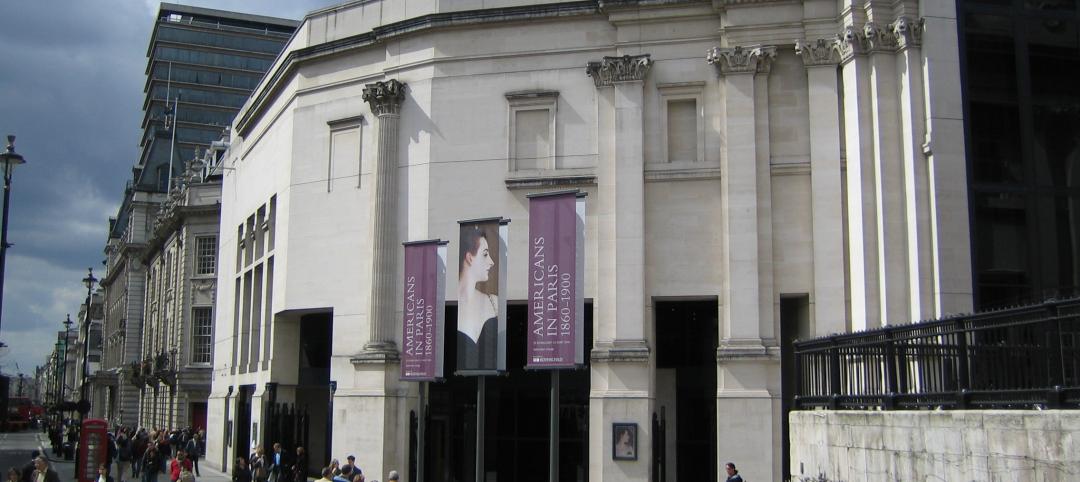The Cuyahoga County Soldiers’ and Sailors’ Monument was dedicated on the Fourth of July, 1894, to honor the memory of the more than 9,000 Cuyahoga County veterans of the Civil War. The small but impressive structure, with a 125-foot column topped by a statue named “Goddess of Freedom,” holds a place of prominence in Cleveland’s Public Square.
In August 2006, the Cuyahoga County Commissioners called for a modest renovation, cleaning, and relighting of the monument, under the supervision of county architect Berj A. Shakarian, AIA, CSI. The $1 million cost was to be raised by a nonprofit foundation, the Soldiers’ and Sailors’ Monument Support Group.
Extensive research by the Cleveland design firm Westlake Reed Leskosky (with Peter van Dijk, FAIA) determined that more extensive work was required than originally anticipated. The roof needed re-caulking. The marble tablets were bent out of shape and discolored. The stained-glass windows needed restoration. In all, the cost would double. Undeterred, the support group raised nearly $2 million from state and county funds and contributions from foundations, businesses, veterans’ groups, and private individuals.
The work began in late 2008. Perhaps the most unusual technical problem had to do with the commemorative tablets. The 4x7-foot slabs, about an inch thick, each weighing 350 pounds, had to be cleaned so that the marble veining could show through the original yellow tint. The traditional technique, mud-based poultice, was ruled out. Research determined that a latex-based cleaning product, if applied and allowed to dry for 13-15 hours, would form a film that could be peeled off. Though tedious, the technique cut the usual cleaning time from three months to three weeks.
Many of the many of the marble slabs were bent out of shape, and the Building Team considered using a method developed by Lord Raleigh in the 1920s—soak the slabs in hot water and bend them back under pressure—but the National Park Service nixed the idea. Instead, to at least stabilize the slabs, the team installed a fin-tube heating system, dehumidifiers, and air-conditioning to control the humidity that was deemed to be the likely cause of the distortion problem.
Detailed research into the marble decoration revealed that the monument had three levels of coloration: tinting (to allow the veining to show through); marbleizing (where veining is augmented or added); and ornamentation (where both tinting and marbleizing are used along with non-opaque colors).
Balancing their research findings, the demands of historical accuracy, and aesthetic interpretation, the team developed a palette of eight colors to restore the original polychromatic interior marbles to their original brilliance. Careful attention was paid to sealing the finishes.
Fourteen Tiffany-style stained-glass windows—two above the entry doors depicting sunrise and sunset, the other 12 portraying military regalia and imagery—were found to be bulging or missing glass. Team members traveled to Chicago to find perfect matches for the missing glass, and the windows were disassembled, repaired, cleaned, and reinstalled.
To enhance the visitor experience, new fluorescent, track, and LED lighting was carefully balanced to enhance the freshly tinted and re-inked lettering of the marble tablets and highlight various accent items.
The final touch had to do with a bronze relief of President Lincoln. Photographic research showed that, as late as 1932, Lincoln was holding the shackles of a freed slave in his right hand, but the shackles had gone missing for more than 40 years. The Building Team restored the shackles in time for the grand reopening last June.
“The research was the most difficult part,” said jurist Tom Brooks, VP, Restoration Division, Berglund Construction, Chicago. Added judge Darlene Ebel, Director, Facilities Information Management, University of Illinois at Chicago, “Restraint was used. It takes a lot of judgment to decide what level of restoration to do. What they did was absolutely right.”
“This is an inspiring project,” said George Karl Tuhowski, III, LEED AP, general superintendent, Leopardo Construction, Hoffman Estates, Ill. “No stone was left unturned.” BD+C
PROJECT SUMMARY
Building Team
Submitting firm: Soldiers’ and Sailors’ Monument Support Group
Owner: Cuyahoga County Soldiers’ and Sailors’ Monument Commission
Architect/Interior design/MEP engineer/Historic specialist: Westlake Reed Leskosky with Peter van Dijk, FAIA
GC: EnviroCom Construction, Inc.
General Information
Size: 1,600 gsf with 125-foot column and statue
Construction cost: $2.0 million
Construction period: May 2009 to May 2010
Delivery method: Design-bid-build
Related Stories
Architects | Dec 16, 2015
Architects create commission for diversity advancement
The 20-member group will assess recent data, set a plan of action, and report on results to the AIA Board of Directors.
Architects | Dec 15, 2015
ULI names Lord Richard Rogers the 2015 J.C. Nichols Prize winner
Rogers, Founder of Rogers Stirk Harbour + Partners, works on projects that “shine a spotlight on the challenges that people in urban areas are facing."
Market Data | Dec 15, 2015
AIA: Architecture Billings Index hits another bump
Business conditions show continued strength in South and West regions.
Architects | Dec 14, 2015
New LEGO line lets builders construct iconic skylines
New York City, Berlin, and Venice are featured in the Architecture Skyline Collection.
Architects | Dec 14, 2015
Date named for announcement of 2016 Laureate of the Pritzker Architecture Prize
The Laureate will be named the morning of January 13.
Architects | Dec 9, 2015
Architecture firms Cooper Carry and The Johnson Studio merge
The combination is expected to bolster each firm’s hospitality-related services.
Industry Research | Dec 8, 2015
AEC leaders say the 'talent wars' are heating up: BD+C exclusive survey
A new survey from Building Design+Construction shows that U.S. architecture, engineering, and construction firms are being stymied by the shortage of experienced design and construction professionals and project managers.
Architects | Dec 4, 2015
Denise Scott Brown and Robert Venturi win 2016 AIA Gold Medal Award
The husband and wife architect team—founders of VSBA Architects and Planners—are the award's first joint winners.
Architects | Dec 3, 2015
LMN Architects wins 2016 AIA Architecture Firm Award
The firm is known for projects like Vancouver Convention Centre West and the University of Washington’s Foster School of Business.
Greenbuild Report | Dec 1, 2015
Data centers turn to alternative power sources, new heat controls and UPS systems
Data centers account for 2% of the nation’s electricity consumption and about 30% of the power used annually by the economy’s information and communications technology sector, according to the National Renewable Energy Laboratory.
















